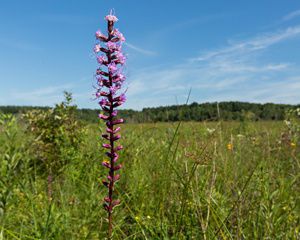
Two Hearted River Aerial view of Michigan's Two Hearted River Forest Reserve, part of the 271,000 acres protected thorugh the Big U.P. Deal. © Drew Kelly

Winding through Michigan's Upper Peninsula, the Two Hearted River showcases the landscapes protected by the Big U.P. Deal, preserving over 271,388 acres of forests, rivers, and wildlife habitats for generations to come.
The Two Hearted River is as beautiful as its name. It winds and cuts dramatically through some of the most picturesque and biologically important undeveloped land in the Upper Peninsula as it makes its way to Lake Superior. Native brook trout abound in its waters, which are kept clean, clear and cold by the surrounding forest.
Twenty years ago, TNC closed on the most significant land conservation transaction in Michigan’s history, forever protecting 271,338 acres and the watershed of the Two Hearted River, in what became known as “The Big U.P. Deal.”
The deal protected the land surrounding some of Michigan’s most iconic Northwoods landscapes, including Seney National Wildlife Refuge, Pictured Rocks National Lakeshore, Tahquamenon Falls State Park, and the Porcupine Mountains State Park Wilderness. Today, it serves as a model of sustainable forestry.
Four years earlier, TNC had learned that the forest’s owners, The Kamehamena Schools—a Hawaiian trust—planned to sell its Upper Peninsula holdings, representing more than 400,000 acres of forest, which risked its fragmentation. TNC partnered with then-Governor John Engler in an attempt to purchase the land, as the owners called for bids but lost out to The Forestland Group.
Thus began a four-year negotiation with the new owners to conserve the most important conservation priorities, approximately 271,000 acres that included most of the watershed of the Two Hearted River, close to 20,000 acres of buffer around Pictured Rocks National Lakeshore and 10,000 acres of buffer and inholdings around Porcupine Mountains Wilderness State Park.
Help Protect Michigan's Biodiversity
You have the power to make a difference for the Great Lakes State and for our planet.
Support Our WorkAlong the way, Michigan’s most influential leaders, foundations and two governors- representing both parties—leaned in to ensure the conservation of this special land.
“The Big U.P. Deal was an extraordinary demonstration of vision and partnership between MDNR and the foundation community-showing what we’re capable of accomplishing by committing early.” Said Helen Taylor, executive director for TNC in Michigan. “They saw the vision as a new way of doing conservation, a win-win for people and nature that respected the local economy, culture, and tax base by retaining it in private ownership while maintaining traditional uses of the land in sustainable forestry and public access for outdoor recreation."
The four-year negotiation to conserve the land had numerous dramatic and significant moments. Early on, Governor Engler recruited the support of the largest foundations in Michigan with a lunch in his conference room, complete with Hawaiian leis and cherry pie. Governor Jennifer Granholm personally intervened to salvage negotiations and bring the parties to a memorandum of understanding on the day before Thanksgiving, 2004. Former TNC Board Chair Phil Power advocated for the deal through the pages of the Detroit Free Press. The County Supervisors of the Upper Peninsula passed a unanimous resolution in support. The foundation community stepped up to commit $40 million in pledges and were patient for four years until the negotiations were completed, including a $10 million lead pledge from the C.C. Mott Foundation after a flyover of the land. The late legendary Congressman John Dingell made urgent calls to the Hawaiian delegation for their support.
Where Wildlife Still Roams
Protected habitat in Michigan's Upper Peninsula supports bald eagles, osprey, common loons, gray wolves, moose, and a magnitude of threatened and endangered plants.
On January 6, 2005, Governor Granholm and TNC announced that they had reached a binding agreement with The Forestland Group on a working forest conservation easement for 248,000 acres and TNC’s acquisition of 23,338 acres that became the Two Hearted River Forest Reserve. The combined $58 million project, officially known as the Northern Great Lakes Forest Project, conserved 271,338 acres.
The deal kept the land in private ownership and on the tax rolls, but open to the public for hunting, fishing, hiking, and grandfathered in existing snowmobile trails to assure the future for outdoor recreation activities. A working forest easement, it kept the land in sustainable production, which has been managed with oversight by dedicated Michigan Department of Natural Resources staff for 20 years. A Public Sector Consultants assessment estimated that the land accounted for $200 million in associated economic activity annually, supporting 3,000 jobs.
From a conservation standpoint, the Big U.P. Deal also linked more than 2.5 million acres of protected federal, state, and natural areas across the U.P. In addition to the 20,000 acres buffering the Pictured Rocks National Lakeshore and 10,000 acres of buffer to Porcupine Mountains Wilderness State Park, the project protected 30,000 acres adjacent to the Hiawatha National Forest, 27,000 acres adjacent to the Ottawa National Forests, and more than 100,000 acres adjacent to state forest lands.
It protected over 300 natural lakes and 192 miles of Class 1 trout streams, including the Two Hearted River—and 522 miles of rivers and streams overall—as well as old-growth hemlock forest and high-elevation peatlands, more than 52,000 acres of wetlands, and habitat for bald eagles, osprey, common loons, gray wolves, moose, and a magnitude of threatened and endangered plants.





A Conservation Corridor Across the U.P.
Connecting the Wilds of the U.P. The Big U.P. Deal linked over 2.5 million acres of protected lands, from the shores of Pictured Rocks to the peaks of the Porcupine Mountains.
TNC’s Two Hearted River Forest Reserve has since served as a laboratory of sustainable forest practices that mimic natural processes and disturbances in order to accelerate restoration and enhance carbon sequestration. It is enrolled in Michigan’s Commercial Forest program and publicly accessible for hunting, fishing, and other forms of outdoor recreation. On the land that TNC continues to own and surrounding the Two Hearted River watershed, TNC and partners surveyed and replaced the majority of road-stream crossing barriers. The work included installing new bridges and crossings that mitigate erosion and provide greater access and upstream movement for 53 native aquatic species, including trout that seek cooler upstream habitat during the heat of summer.
A dedication site to the Big U.P. Deal stands at TNC’s McMahon Lake Nature Preserve, within the Two Hearted River watershed. You can read about it from there, near the parking area, along with an Ernest Hemingway passage from “Big Two-Hearted River”, his short story published 100 years ago in 1925’s In Our Time.
To really understand the quoted passage, though, go up to the road just a little way to the state forest campground on the Two Hearted River. Make your way down the water carefully. Cast your fly upstream and let it float down along the seam of the current, clean water purified by the 271,338 protected acres surrounding it.
“The river made no sound. It was too fast and smooth, At the edge of the meadow, before he mounted to a piece of high ground to make camp, Nick looked down the river at the trout rising.”

The Two-Hearted River in Northern Michigan was made famous by Ernest Hemingway's story "Big Two-Hearted River"

Looking for More Ways to Get Involved?
Sign up to receive monthly conservation news and updates from Michigan. Get a preview of Michigan’s Nature News email.






